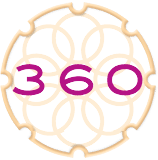Facial Pain
Presenting symptoms
A 30 year-old woman presented with a history of Bell’s palsy that was later re-diagnosed to Tolosa-Hunt syndrome (non-specific inflammation in the superior orbital fissure). Symptoms began during a long international flight. She was bed-ridden for two months with left-sided palsy and pain behind the eye. She was treated with steroids and antibiotic medication. Five years later she still complained of episodic headache and facial pain.
Evaluation, clinical reasoning & treatment strategizing
Small in stature, the patient described that she had put on weight (steroid side-effect). She exhibited a forward head position, a head tilt to the right, protracted scapulae, and limited jaw opening when speaking. Facial symptoms had progressed from the left side to the right with a temporal headache. She reported teeth grinding (bruxism) and a constant metallic taste in her mouth. She failed the two-knuckle test (jaw opening that didn’t allow two knuckles between the front teeth) and her neck range of motion was greatly reduced. Many neck and facial muscles were hypertonic (excess tension) to palpation. The plan was to address the upper-crossed syndrome (a posture dysfunction) and correct forward head positioning to reduce pressure on jaw and facial muscles.
Treatment
Initially, hands-on therapy was applied gently and generally so as to avoid facial nerve irritation. Subsequent treatments were focused on trapezius, the splenii, semispinali, the styloid process muscles, and the muscles of the jaw and face. Extra and intra-oral NMT was performed. Unfortunately, at the beginning these techniques treatments provided only moderate relief. It was decided to use some St John NMT ‘cranial decompression’ techniques. The sphenoid lift technique was able to mimic the intense pain behind the eye. Decompression of the zygoma bone (a gloved technique inside the mouth using gentle superior direction pressure on the cheekbone) relieved this pain.
Outcomes and follow-up
Eight treatments helped us make excellent progress, but because she travelled so much, more emphasis was put on home-care activities. The patient was instructed in exaggerated shoulder shrugs and rolls, trapezius and levator scapulae stretches, a jaw muscle selfetch and the Brűgger relief exercise (see our blog for details). Suggestions were made to correct her nighttime habit of sleeping on her stomach, to begin an exercise routine, and to improve work-station ergonomics. Independently, she decided to have all her mercury fillings removed to address the metallic taste in her mouth.
